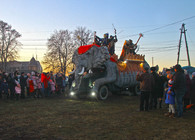On January, the 14th a district festival of Malankas takes place in Chahor (but read the announcements, Covid is very tricky). It is logical: long before Malankafest, which legalized the appearance of Malanka in the regional center, Chahor for many years attacked neighboring Chernivtsi with its steep platforms, made circles near the Cheremosh Hotel and on the Main street (Holovna), bringing a little festive chaos to the metropolis. (It would be oK, but the music — oh. There were problems with it: it was low-grade Russian-language pop).
And here is interesting aspect: Chahor was once a village, but became a typical suburb of the regional center. How many spears are broken in the discussions about whether to bring rural culture to the city! Here is another aspect of this eternal controversy: the narrow village streets were not enough for Chahor“ Malanka - and it began to raid the city. Only bright platforms took part in the raids - no traditional characters who moved on their feet, not on wheels. Was it bad or not?
Chahor“s motorized Malankas left in their native village what the snobbery of the townspeople did not accept: Bears and Jews, Doctors and Malankas - in fact, folklore, the origins of the holiday. But the modernized Malanka on wheeels was raised to a really high level. The malankars of Chagor (and their neighbor village of Koroviya too) were returned to the city what it had lost, in the form in which the city was ready to accept it. Modernization. Renowation. Carnival for carnival sake. In this form, Malanka would have survived to the XXI century, if not the villages in the middle of nowhere, far from the roads, which preserved the authenticity of ancient ritual.
(It should be added that the platforms in Chahor are always very expensive, but lack of taste is often the problem. During the war with Russia they made a platform with «Fairytale Rus», for example, and Tutankhamun wore in 2017 the mask of Putin)
But Malankafest launched a reverse process. From modernization to origins. In Chahor in 2016, the folk rite began to be revived almost from scratch. For several years now, four Horsemen and four Officers have been walking and dancing in the village again (They are traditional characters for this region). It is not the Commandant who waves the mace in front of the "horses'" noses, but the Jew - an interesting detail.
Another team of young men revived a more classic Ukrainian Malanlka - with a Jew, Grandfather, Grandmother and Gypsy...



























